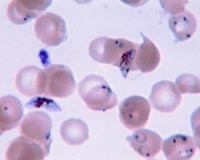| . |  |
. |
Washington DC (SPX) Mar 04, 2011 Researchers from the National Institute of Standards and Technology (NIST) and the Weill Cornell Medical College have designed artificial "protocells" that can lure, entrap and inactivate a class of deadly human viruses - think decoys with teeth. The technique offers a new research tool that can be used to study in detail the mechanism by which viruses attack cells, and might even become the basis for a new class of antiviral drugs. A new paper details how the novel artificial cells achieved a near 100 percent success rate in deactivating experimental analogs of Nipah and Hendra viruses, two emerging henipaviruses that can cause fatal encephalitis (inflammation of the brain) in humans. "We often call them honey pot protocells," says NIST materials scientist David LaVan, "The lure, the irresistibly sweet bait that you can use to capture something." Henipaviruses, LaVan explains, belong to a broad class of human pathogens-other examples include parainfluenza, respiratory syncytial virus, mumps and measles-called enveloped viruses because they are surrounded by a two-layer lipid membrane similar to that enclosing animal cells. A pair of proteins embedded in this membrane act in concert to infect host cells. One, the so-called "G" protein, acts as a spotter, recognizing and binding to a specific "receptor" protein on the surface of the target cell. The G protein then signals the "F" protein, explains LaVan, though the exact mechanism isn't well understood. "The F protein cocks like a spring, and once it gets close enough, fires its harpoon, which penetrates the cell's bilayer and allows the virus to pull itself into the cell. Then the membranes fuse and the payload can get delivered into the cell and take over." It can only do it once, however. The "honey pot" protocells have a core of nanoporous silica-inert but providing structural strength-wrapped in a lipid membrane like a normal cell. In this membrane the research team embedded bait, the protein Ephrin-B2, a known target of henipaviruses. To test it, they exposed the protocells to experimental analogs of the henipaviruses developed at Weill Cornell. The analogs are nearly identical to henipaviruses on the outside, but instead of henipaviral RNA, they bear the genome of a nonpathogenic virus that is engineered to express a fluorescent protein upon infection. This enables counting and visualizing infected cells. In controlled experiments, the team demonstrated that the protocells are amazingly effective decoys, essentially clearing a test solution of active viruses, as measured by using the fluorescent protein to determine how many normal cells are infected by the remaining viruses. The immediate benefit, LaVan says, is a powerful research tool for studying how envelope viruses work. "This is a nice system to study this sort of choreography between a virus and a cell, which has been very hard to study. A normal cell will have tens of thousands of membrane proteins. You might be studying this one, but maybe it's one of the others that are really influencing your experiment. You reduce this essentially impossibly complicated natural cell to a very pure system, so you now can vary the parameters and try to figure out how you can trick the viruses." In the long run, say the researchers, the honey pot protocells could become a whole new class of antiviral drugs. Viruses, they point out, are notorious for rapidly evolving to become resistant to drugs, but because the honey pots use the virus's basic infection mechanism, any virus that evolved to avoid them likely would be less effective at infecting normal cells as well. M. Porotto, F. Yi, A. Moscona and D.A. LaVan. Synthetic protocells interact with viral nanomachinery and inactivate pathogenic human virus.
Share This Article With Planet Earth
Related Links National Institute of Standards and Technology (NIST) Epidemics on Earth - Bird Flu, HIV/AIDS, Ebola
 Floating Spores Kill Malaria Mosquito Larvae
Floating Spores Kill Malaria Mosquito LarvaeWashington DC (SPX) Feb 23, 2011 There are over 200 million cases of malaria each year and, according to the World Health Organisation, in 2009 malaria was responsible for 781,000 deaths worldwide. Malaria is spread by mosquitoes which breed in open water and spend much of their larval stage feeding on fungi and microorganisms at the water surface. New research published in BioMed Central's open access journal Paras ... read more |
|
| The content herein, unless otherwise known to be public domain, are Copyright 1995-2010 - SpaceDaily. AFP and UPI Wire Stories are copyright Agence France-Presse and United Press International. ESA Portal Reports are copyright European Space Agency. All NASA sourced material is public domain. Additional copyrights may apply in whole or part to other bona fide parties. Advertising does not imply endorsement,agreement or approval of any opinions, statements or information provided by SpaceDaily on any Web page published or hosted by SpaceDaily. Privacy Statement |